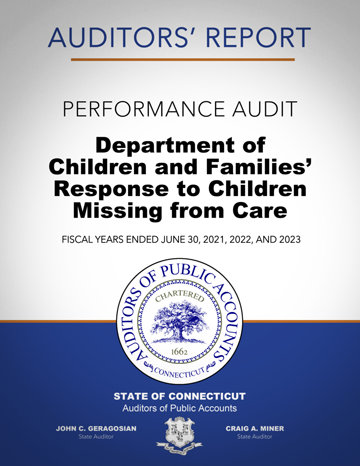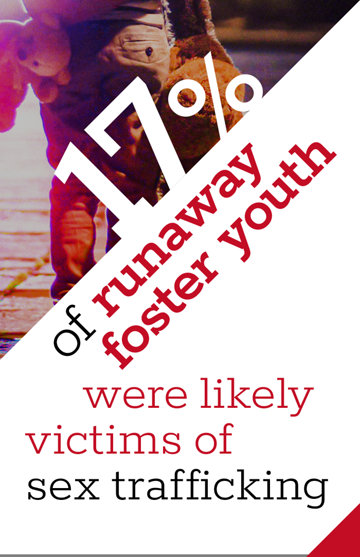Those runaway foster kids—with no family and often mistreated at their assigned homes—who pack up their few miserable possessions and run away into the dark night.
Where did they go?
And even when they are found and returned or rehoused, where have they been?
Were they easy prey for sharp-eyed, avaricious pimps who can spot a lost, confused, penniless foster runaway on the street from a mile off, offer them false hopes of help and trap them into the nightmare of sex trafficking?
Well, don’t bother asking the Connecticut Department of Children and Families (DCF), which has the responsibility of caring for and protecting kids without families. They haven’t got a clue.
The same six foster youth went missing from care 341 times in three years.
According to a shocking recent report from the state’s Auditors of Public Accounts entitled “Performance Audit—Department of Children and Families’ Response to Children Missing from Care,” the state doesn’t seem willing or able to take decent care of runaway foster children.
In fact, they often don’t even bother to notify authorities to look for them and, if and when the children return, they don’t ask if the children have been victims of human trafficking.
But the odds make it shockingly likely that they have been.
“According to the National Center for Missing and Exploited Children (NCMEC), children in foster care are particularly vulnerable to human trafficking, with 17 percent of all children and 27 percent of female children missing from care suspected of being trafficking victims,” the report states.

The report found that there were 3,736 instances of missing children from foster care between 2021 and 2023, involving over 600 children.
“DCF did not document or failed to provide the required notifications to police and other stakeholders and did not request or document the reason children went missing from care,” the report reads, stating that staff did not have “procedures for screening all missing children for sex trafficking.”
DCF has, in effect, been stocking the streets with runaway children—prime targets for sex trafficking—and, in doing so, essentially partnered with pimps, who need only reel the youth in.
In fact, the same six foster youth went missing from care 341 times in three years—and “all experienced sex trafficking victimization or juvenile justice system involvement.”
AbleChild, an organization that battles the psychiatric labeling and drugging of children, stated, “The recently released DCF audit revealed a system that repeatedly failed to protect children, with ... little meaningful oversight or reform.
“DCF has long presided over the mass psychiatric drugging of children under Medicaid, often without proper informed consent or transparency.
“The agency’s lack of accountability left children exposed to exploitation, wrongful medication and abuse, while the public was kept in the dark about the true scope of the problem.”
Human Trafficking Search (HTS), a free global database made available by the anti-trafficking nonprofit Freedom United, states on its website that “98 percent of children who are identified as survivors of sex trafficking had previous involvement with child welfare services.”
“Unfortunately, the foster care system is a pipeline to trafficking,” HTS continues. “Traffickers still actively target foster children.”
It’s a national and growing problem: In 2019, 29 states reported 877 sex trafficking victims. In 2020, 35 states reported 953 such victims.
“Some traffickers specifically target children in foster care because they know these children are less likely to have supportive adults in their lives.”
The National Council of Juvenile and Family Court Judges concluded, “Traffickers are targeting and recruiting youth directly from foster care, group homes and residential placements.”
The route from foster care to sex trafficking has been well known for many years, but the public remains largely unaware of the extent and, indeed, the very existence of the problem.
Yet it is far too prevalent. And it’s a nightmare that our foster care system—supposedly designed to protect children whose families have failed them—is just another system failing them, and even feeding them into the horror of sex trafficking, a fate from which they may never emerge alive.

“Some traffickers specifically target children in foster care because they know these children are less likely to have supportive adults in their lives and more likely to have unmet needs,” the report states. “Children may remain in trafficking situations because they see the trafficker as a romantic partner or fear them.”
NCMEC works to track down missing children and should be notified of runaways, but DCF only notified NCMEC of 33 percent of runaway incidents between 2021 and 2023.
In summary, there appears to be a coverup intended to hide a situation of national shame: When foster kids run away in Connecticut, no one goes looking for them, and they are thrown into desperate situations where all they have to trade for their survival is their bodies.
Caregivers, foster “parents,” are required to notify authorities when their foster children go missing, but often do not—for a very good, if despicable, reason: money. In New York, it was revealed that hundreds of foster parents continued to receive up to $1,700 per month for children who no longer lived in their foster “home.” Reporting the runaway would, of course, mean the cash drying up, so some say nothing.
A real crackdown is needed on foster agencies—starting with proper training, enforced reporting, effective location of runaways, and investigations and prosecution of human traffickers. Every effort must be made to help foster children return to safety, stability and a real home.
But first of all, as a humane society, we must care.
If Connecticut is any gauge, we’re not there yet.






















